Farm Slaughter
Step-by-Step Instructions
Warning, some of the following images are graphic and may be unsuitable for small children or vegans.
On-the-farm slaughter of your goats can be a wonderful way to enjoy the fresh, natural product you’ve worked so hard to produce. It doesn’t take long to process a goat, and if done humanely, it gives you peace to know that your goat spent its entire life in your care, without suffering stress or pain.
This is a primer on the basics of on-the-farm slaughter. There is more than one way to do this, of course, but this is the method chosen by the experts this day.
First, have a plan. Do you want just the meat, or do you want the organs and hide too? Breaking down a carcass can be intimidating if you’ve never done it before. Some farmers simply strip every bit of flesh off the goat skeleton and make hamburger. Others are careful to keep whole sections intact for roasting, etc. Some farmers love the liver and heart. Know what you want and how to make it work before you’re faced with a dead goat hanging in front of you. There are plenty of resources online to help you prepare.
Gather your equipment. For those who are avid deer hunters, this might be just a pocketknife and some plastic bags. But it’s best to take advantage of the resources most people have on their farm.
A deer gambrel and a front-end-loading tractor can be used to hoist the goat carcass in the air. A skinning knife, a gut hook knife, a fillet knife and a very sharp butcher’s knife will also come in handy. A large bucket (muck buckets work great) to catch the blood and offal is recommended. It’s also nice to have a table covered in butcher paper on which you can dissect your goat parts.
A hose with fresh water is a plus to have handy, as is a Butt Out tool with twine. If you plan on cutting the carcass in half along the spine, a hand meat saw, or even a reciprocating saw (Sawzall, etc.) with a clean blade can save you a lot of effort. Disposable rubber gloves are also nice to have, and you’ll need plastic bags, or coolers or something to hold your meat.
How these items are used will be explained in the step-by-step instructions.
Choosing your goat is purely a matter of preference. Those experienced in on-the-farm slaughter recommend that you choose an animal that hasn’t been eating recently. If possible, select your goat the night before the slaughter, and put it in a stall or enclosure where it can’t graze during the night. A full goat rumen can make a very big mess.
Animal welfare organizations recommend a captive bolt gun for livestock slaughter, but most small farmers don’t have one. Instead they use common firearms. Only adults, with extensive use in the safe operation of firearms should attempt to slaughter a goat using a firearm. Discharging a firearm is ALWAYS potentially dangerous. If you have any doubts about using a firearm safely, DO NOT ATTEMPT TO SLAUGHTER A GOAT WITH IT.
Humane slaughter means the goat suffers minimal stress and is killed as close to instantly as possible. Most livestock killed by a firearm are shot in the forehead, at the intersection of two lines, one running from the right ear to the left eye, and the other line running from the left ear to the right eye.
“This method is not suitable in mature goats, as the brain is located well back in the skull compared with other livestock.” — Department of Environment and Primary Industries, Australia.
Goat skull, with red circle indicating the location of the brain relative to the horns and forehead
As you can see from the photo above, the goat brain is behind several inches of bone and tissue. Therefore, it is recommended that a goat be shot from behind the head.
“The optimum position (for humane shooting) for heavily horned sheep and horned goats is behind the poll, aiming toward the angle of the jaw.” — Human Slaughter Association, http://www.hsa.org.uk
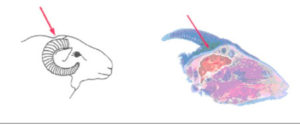
Proper angle for shooting heavily horned sheep and horned goats – photo Humane Slaughter Association
Most farmers have success with small caliber weapons (.22 LR), but larger calibers can be used. What’s important is that the bullet hit the brain, causing instant death.
Exactly how you isolate and manage the shooting of the goat will vary from farm to farm. Most farmers separate the (hopefully hungry) goat from the rest of the herd and then offer it some grain or other goat treat. While the goat is preoccupied with eating, it is shot from behind.
Even with a perfect “brain shot” there will probably be some degree of spontaneous movement of the goat’s limbs. This is a common spinal reflex that happens in most animals. It does NOT involve brain activity and is not a reaction to pain or fear or any other conscious thought. A goat’s muscles can twitch and spasm long after it’s organs have been removed.
Immediately after the goat has been put down, it is recommended that its throat be slit to facilitate the draining of blood. This is done with a very sharp butcher’s knife (or similar). Make a deep cut just below the angle of the jaw to include carotid arteries on both sides of the neck. The goat is dead and cannot feel pain, so don’t hesitate to make the incision deep and complete.
Next, make a small slit between the tendon and bone on the back legs of the goat. Think of the small area of tissue between your ankle bone and your Achilles tendon. Look for that same area on the back legs of the goat.
Insert the hooks from the deer gambrel and hoist the goat to a comfortable height. Place the gut bucket underneath to catch the guts and blood.
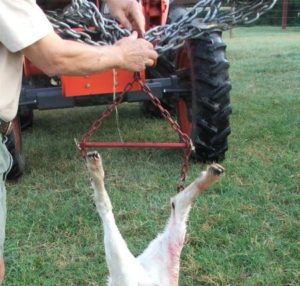
Hang goat using deer gambrel
Cutting the hide only, cut circles around each back leg under the gambrel hooks.

Cut through hide around each rear leg
From each circle, cut the hide down the inside of each leg, connecting the slits in the crotch.
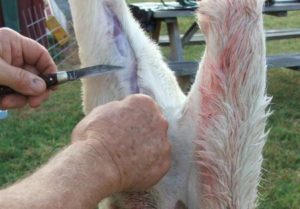
Cut slits down both legs
Now is a good time to put on rubber gloves. Push the Butt Out tool into the anus all the way, then rotate the tool about 1.5 turns. Cut through the hide around the anus, keeping about half an inch of hide around the anus, and then pull the Butt Out tool out of the anus about 10 inches.
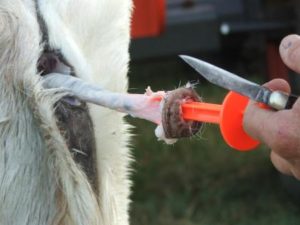
Removing the anus with the Butt-Out tool
Tie a string securely around the intestine between the Butt Out tool and the goat. Then cut away the Butt Out tool, leaving as much intestine beyond the tied-off portion as possible. This will prevent any fecal matter from contaminating the meat.
Now start skinning the goat with your skinning knife. A skinning knife is the preferred tool because it has a rounded cutting blade. This prevents unnecessary nicking of the meat and the hide, which can be saved for tanning.

Skinning the goat
If your goat was a male, be especially careful as you approach the testicles and penis. You don’t want to nick the bladder or the urethra, which can result in urine spilling everywhere.

Be careful when skinning near the genitals
Carefully cut around the testicles, pulling and cutting as you go. Some people eat the testicles (they’re quite good) and others have made things like ammunition bags out of the scrotum. Scrotum and testicles can be removed at this point.
Using the gut hook knife, slit the skin down the center of the chest to the base of the neck between the front legs. Be careful not to cut into the abdominal or chest wall.
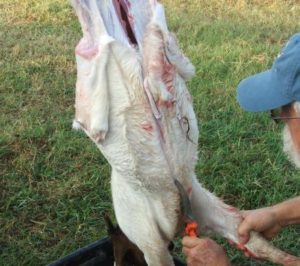
Cutting the hide down to the front legs
Continue skinning the goat until your reach the front legs.

Continue skinning the goat
Again, using the gut hook knife, slit the abdominal wall carefully without cutting into the intestines or stomach so you don’t contaminate the meat. Carefully remove the organs (you may have to lift some over the rib cage), saving what you want and discarding the rest.

Removing the guts and organs
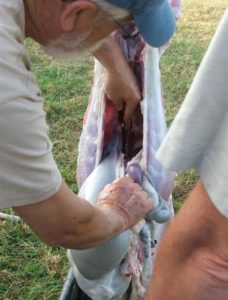
Removing the guts and organs
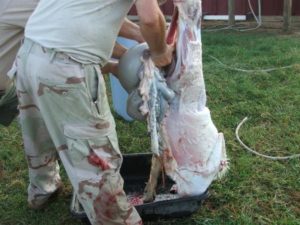
Removing the guts and organs
While some people continue with the goat hanging from its rear legs, these experts chose to remove the goat from the hooks and re-hang it from it’s front legs, making access to the head and neck easier.

Hanging the goat from the front legs
The goat’s front legs are hung and skinned just like the rear legs. The hide is removed from the neck and head as carefully as possible so as not to damage the meat or hide.
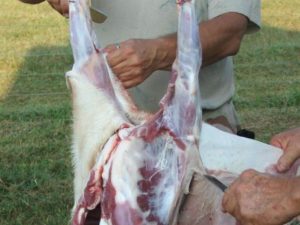
Hide is removed from front legs
Once the hide is completely removed it can be disposed or retained for tanning. This hide was kept and sent to a tanner.

Complete goat hide
The head is removed by cutting through the muscle and massive tendons as close to the skull as possible. The neck meat is considered a delicacy.
If you want to cut the carcass in half you need to make a cut down the back (you won’t be able to cut through the ribs).
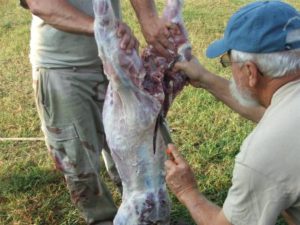
Make a cut down the back
Using a meat saw or your favorite power tool, cut through the ribs and down the spine. The lower part of the back legs, and eventually the lower part of the front legs, will also be removed with this saw.

Cutting the carcass in half with a saw
This carcass was left in halves for roasting. What you do with yours from this point up to you. Bon appetit.
—————————————-
Thanks to David Hudson and Ned Strange, Sr. who slaughtered and dressed this goat.
All photos were taken by Leslie Keck.